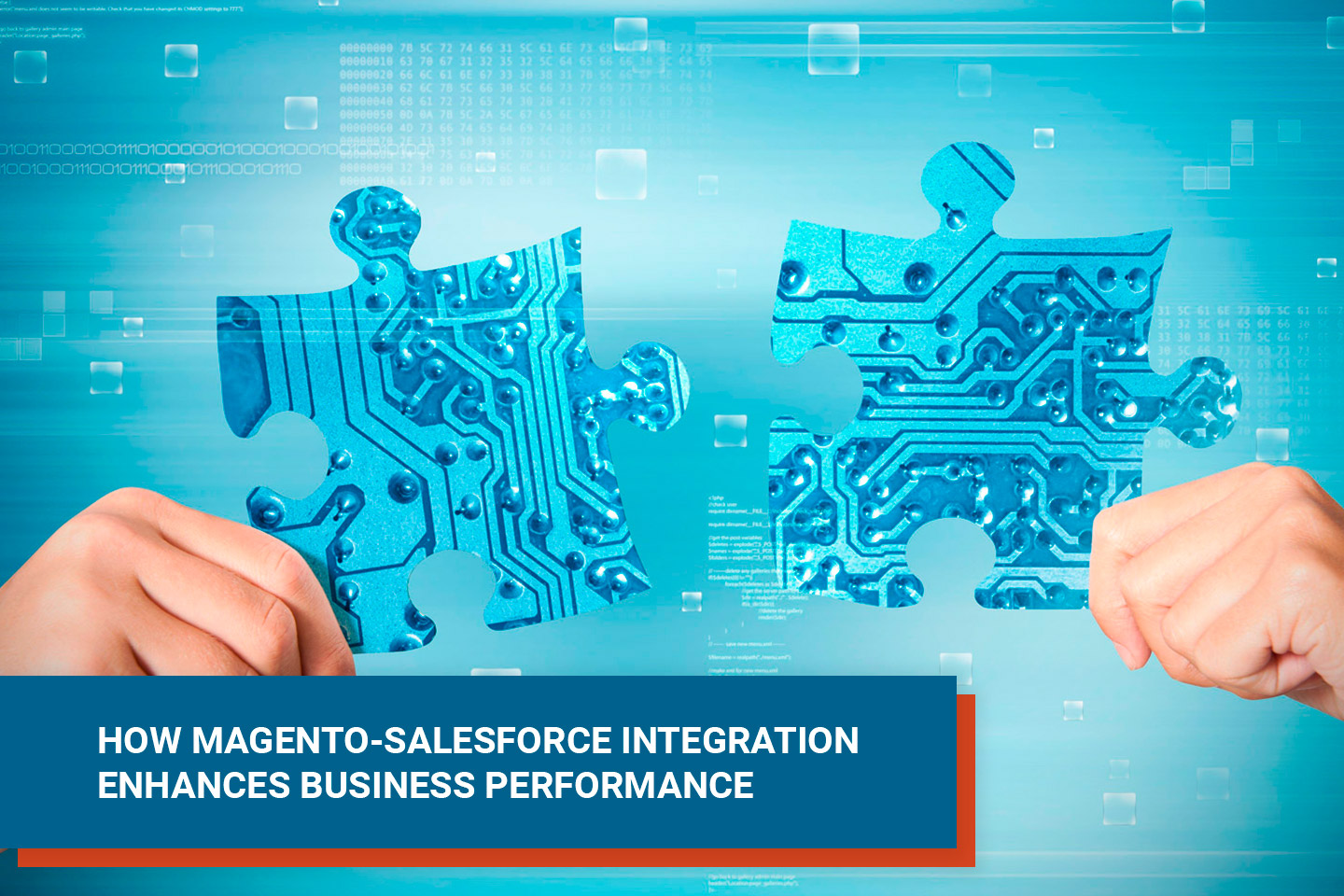ROI Part 3: Your Magento Salesforce Integration Options
 Igor Krasnykh
·
5 minute read
Igor Krasnykh
·
5 minute read

This is the final article in a 3-part series on how Magento-Salesforce integration can increase the ROI for businesses. Be sure to read parts one and two.
When it comes to integrating Magento and Salesforce, there are many solutions available. This can make it difficult to know which one is worth your investment.
The PowerSync connector is a popular option, but how does it compare? Here is a side-by-side look at how to choose the best option depending on your need.
An online automation tool or connector (SaaS)
The most popular example of an online automation tool or connector (SaaS) is Zapier. Zapier integrates with more than 1,500 apps and provides basic lookup, create and update capabilities.
For example, with Zapier, you can create a Salesforce Lead each time a Magento customer is created, or you can create an Account + Contact in Salesforce within the same flow. You are able to push data between Magento and Salesforce easily based on basic events that are triggered in each platform.
So, what are the gaps?
This solution charges per volume and the number of steps in your process. It can get quite costly if your flows are complex and require lots of conditional logic. The cost can add up particularly fast if you have a high volume of data going through your website.
Zapier also has limitations when it comes to the reused logic in IF/ELSE conditions, causing the need to create several duplicate steps in your rules. As a result, your virtual runway can quickly end, stalling or halting the successful completion.
A third gap is an inability to handle complex conditional logic. I many cases the flows halt unexpectedly. Ideally, a connector would handle complex logic conditions gracefully, allowing you to proceed with the next task.
With Zapier, there is not a clear process or timeline for implementing custom options. This is a problem for serious entrepreneurs who need solutions unique to their business processes.
A quick summary
While Zapier has its perks, it is best suited for growing businesses that need a very basic level of integration between Magento and Salesforce. For example, if your business only requires synchronization for creating customers, handling contact information updating contact information and capturing new records, this solution may work for you.
Off-the-shelf products

Some off-the-shelf products are cheap (only a few hundred dollars), and others are expensive (several thousand dollars per year). Some are similar to Zapier and live in the cloud while others are extensions that are installed into Magento and Salesforce directly.
These products have a medium to great amount of business logic embedded into them. This logic eliminates the manual setup effort that is required by a product like Zapier, which can save you days or weeks. Best practices are also already implemented, so you don’t have to reinvent the wheel on your own.
So, what are the gaps?
The first gap that exists with these solutions is they require a lot of technical support when there is a software update.
Second, many cheaper solutions (less than $200-$300) in this space do not come with support. You may have 30 to 60 days when a developer will work with you, but you will most likely have to pay again when there is a new major version available. Adding to the frustration, many companies are overseas and it can be impossible to get in touch with them. These developers also often are not open to solve complex issues and often ignore such requests.
Third, almost all cheap Magento-Salesforce integration solutions lack features, flexibility, and scale. These solutions are typically built for very narrow use-case and require additional development effort (which can get costly and very quickly).
Fourth, these products are often not easy to set up on your own. Many times, the product developer or system integrator has to set it up for you. You need someone with expertise in this area, otherwise, you may find yourself in a situation where you wasted time and money.
A quick summary
While off-the-shelf products beat out online tools for efficiency and effectiveness, they may only be worth the consideration for common retail businesses that are relying on Salesforce for more than a marketing solution. If you are just starting with the Salesforce Sales Cloud, it may make sense to start with a less expensive solution.
You’ve heard the saying “You get what you pay for”. The same is true when it comes to digital services. Every business hopes to save money, but you will have wasted your resources if the integration product you purchase does not meet your business needs. While high-quality products may cost more, they also work smoothly, come with dedicated support and help you get a 360-degree of your customers.
A completely custom integration
Many development companies claim they can build any integration. This route requires a larger up-front investment compared to the cost of out-of-the-box products. It also requires a detailed specifications document (or scope of work document) in order for the project to be successful. It’s assumed that in order to get all the requirements, you will need to have many meetings with the technical teams throughout the project to learn and implement your company’s business processes. In the end, you get the individually tailored solution, and it will fit all of your business needs.
So, what’s the catch here?
First, it is almost impossible to iron out all the use cases and predict any edge cases that may or may not happen with your system’s data in the future. Usually, the initial deliverable you receive will require additional work and will result in a fluid deadline.
Keep in mind, the extra time and additional requirements will cost you more money and increase the total price of the product. You will almost always end up paying more than you initially intended.
A quick summary
If you are a large corporation with many custom processes and flows and use many systems that have to communicate with one another to ensure a complete equilibrium, this is the route for you. In such cases, there is no off-the-shelf product or combination of products that will meet your needs out of the box. Therefore, custom integration is your only option if none off the shelf products can get you from 0% to 80% while allowing you to build the last 20%. PowerSync could also be a good option here since the Magento solution is fully open-source and built to support further on-demand customizations.
How PowerSync can help you integrate Magento and Salesforce platforms together?

To integrate Salesforce and Magento, you can opt for an off-the-shelf solution built by PowerSync. This extension enables bulk data synchronization, as well as manual synchronization of individual records from Magento to Salesforce CRM and back.
The extension is available for Magento Open Source, Magento Commerce and Magento Commerce Cloud version. It is trusted by many popular brands in the world with a large (millions+) order, customer and product volumes. To use this extension, you will need to have a Salesforce CRM account. Prices for Salesforce CRM service start at $25/month and you can learn more about the plans available on the Salesforce website.
Sales Cloud + Magento or Service Cloud + Magento
You might be a retail business selling goods or a service provider, but in both scenarios, you have leads, customers or clients, and sales transactions. PowerSync’s Magento-Salesforce integration supports all of these use cases and provides a powerful and flexible integration that allows you to adjust the integration logic & process via simple configuration settings in the Magento Administration Panel.
Marketing Cloud + Magento
Marketing Cloud is often coupled with Salesforce Sales Cloud. It is a platform used to engage with your customers throughout their virtual lifecycle. Customer engagement can take place through social channels email, phone/text messages, chatbots, etc. Integration between Magento, Sales Cloud and Marketing Cloud helps you not only track customer value but also their engagement with your brand.
Custom solutions
We want to emphasize that the PowerSync product for Magento and Sales Cloud fits ~80% of all use cases that have been observed on the market today. There are, however, business processes and implementations out there for the Magento eCommerce platform or Salesforce Sales Cloud that may require a custom effort. No matter what the need is, the PowerSync team can help you get the Magento 2 Salesforce integration working the way you desire. No job is too big or too small for PowerSync.
To sum it up
Integrating systems that collect diverse customer information from various channels can be beneficial for an eCommerce business. This is particularly true for online shops, which have access to valuable CRM data. This includes both the direct information collected from the website input forms (e.g. personal data, indirect hints the customers leave while navigating, browsing, abandoning carts, etc.).
An integrated Salesforce CRM system allows Magento business owners to centralize all data required for developing a personalized approach quickly. As a result, you are likely to win more loyal customers by adding more value to their lives.
Read more about the reasons why eCommerce stores are flocking to Magento. To find out more about Magento and Salesforce CRM integration, and PowerSync’s gradual process for moving data from Magento to Salesforce, read our previous article.



